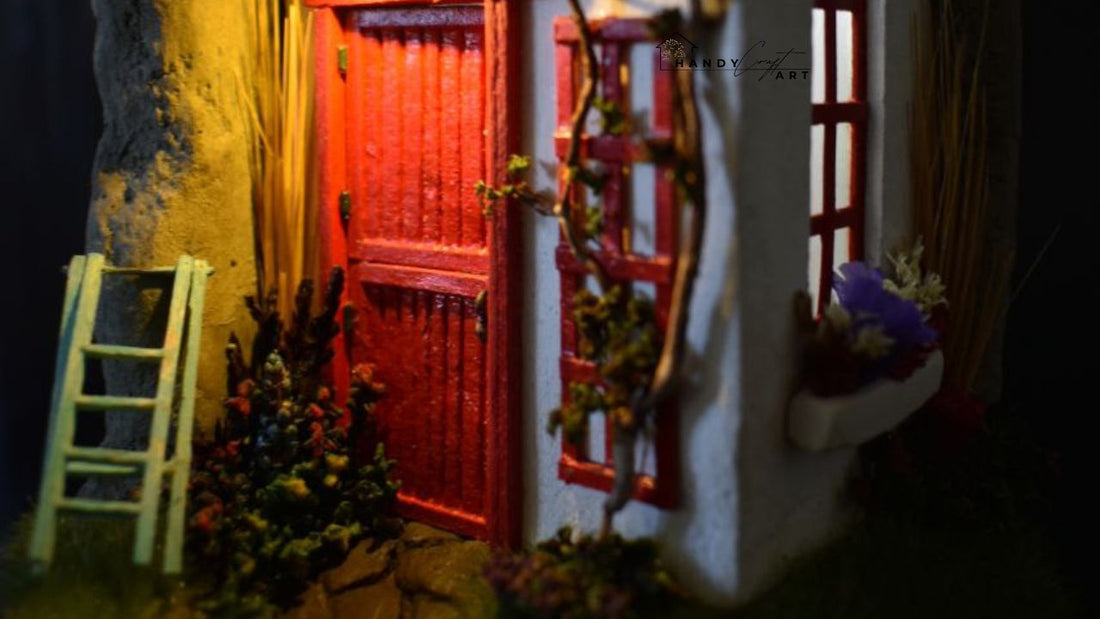
Perfectly cut, neatly assembled — but lifeless. Why? Why do some miniatures come alive while others remain just models?
Share
When we talk about realism in miniatures, we often mean something much broader than just resemblance to reality.
In fact, it’s not always about “looking like a real house” or “a replica of a building.” Rather, it’s about making you believe: this could exist. Even if it’s in another world.
All the magic is in the logic
Remember the worlds of Avatar, Hogwarts, or Star Trek. These are fantasy worlds, yet we believe in them.
Why? Because they are built consistently, with details, logic, and texture. The same applies to miniatures: you don’t have to create an exact copy of a building — you need to achieve a feeling of reality.
We believe in a scene if it:
- Looks logical within its own universe
- Is made with attention to detail
- Does not contradict the viewer’s experience
A fairy-tale tower can be unnaturally narrow and tall — if in the world where it stands, that is possible. But if everything is made from the same plywood, the same colour, thickness, and texture — the viewer sees, “this is just a craft.”

In this fantasy miniature of a forest house by the lake, delicate, intricate details are especially important — for example, the elegant thin rods on the door, reminiscent of metal mullions. It is precisely this precision and subtlety in the small elements that preserve the atmosphere of realism and prevent the scene from turning into a toy.
What makes a diorama “real”?
- Texture — materials should convey a sense of weight, time, age, and weather.
- Proportions — sizes and thickness of walls, windows, plants, signs. Balcony rails shouldn’t be as thick as a door, and flower pots shouldn’t be half the size of a window.
- Color — harmony is important. Random colors “from the set” rarely work well together.
- Deliberateness — when the choice of material or shape looks intentional, not just a forced solution.
What breaks the magic of a miniature
The viewer senses falseness instantly — in a fraction of a second.
Even if someone worked carefully, glued everything neatly, painted it — but used the same moss everywhere, the same material for walls, windows, and roof… the viewer doesn’t believe it. It looks like a hobby kit, not a small world.
- Everything made from one material (plywood, one flock, one moss)
- Plants just “stuck on” because there was nothing else
- Thicknesses of elements are not differentiated
- Poor material combinations (flock shines like tinsel next to matte plants)
This is not a mistake. It’s simply not art, but a raw craft or hobby project. And that’s fine when you planned it, like assembling a KIT set. What’s frustrating is when a miniature “fails” because of details: weak texture, out-of-scale flower pots, monotonous plants, poor material combinations, coarse details, “plastic” elements. All this breaks the magic of perception.
Mistakes? I've had them. Photos? None. My ego wouldn’t survive that kind of exhibition.
And using someone else’s work as a “bad example” — that’s just unethical. We’re all in progress, and every stage deserves respect.
Choice or necessity
The same set of materials can look either like a forced measure or a strong artistic choice.
I created a scene where almost everything was built around ferns — and that was intentional. They set the texture, rhythm, creating an “overgrown and abandoned” effect. Only near one house did I add small domestic bushes — so that against its background, the ferns looked even bigger, and it was a deliberate simplification of architecture and vegetation.

The book nook with deliberately simplified white houses and ferns is an example of a stylistic choice to create the atmosphere of a world. The minimalist concept of the buildings echoes the minimalism in the plants and composition. Everything is built on simple shapes, color, and texture.
Repeating the same element is not a problem if it’s part of the rhythm. But if it’s not rhythm, and the same plant appears everywhere just because there was no other option — that’s not style, but necessity. And it’s read instantly.
A story without heroes
In most of my miniatures, I don’t use human figures. This is a conscious choice.
My miniatures are not a story moment, but a field for it.
I want the story to be born in the owner’s imagination. For the person to decide who lives there. For the scene to “sound” differently on different days. For the miniature to live.
It’s not a limitation or a lack of possibility — today there is excellent casting and great materials. But for me, a miniature is not a “frozen frame” or a concrete story, but a space where a story can happen anew every day.

This book nook is a space for imagination, where there are no specific heroes, but there is an atmosphere and a courtyard story whose details anyone can imagine as they wish. The overall muted color scheme and bright bursts of color help the scene “breathe” and live its own life. The textures and materials support the illusion that this courtyard is very old and has stories to tell.
It’s important that the viewer fills in who lives there and what happened. That the scene “breathes” and doesn’t lose meaning over time. Today you see one life in that house, tomorrow — another. And that makes the scene alive, even without figures. It’s not just architecture, not just a landscape. It’s a moment torn from a world that may not even exist, but one you can easily believe in.
It tells about a place, but doesn’t impose a plot.
I don’t care how accurately the roof or fence is repeated — I care about how it “sounds” together, what atmosphere it creates.
It’s not a model, but a fragment of a world where you want to be.
